Birdingpals Trip Report
Click here for more trip reports in Argentina
Alec Earnshaw's great report from the province of Cordoba
Trip report Argentina March 16 to April 12/2006
by Birdingpal Knud Rasmussen
This is my second trip to Argentina a country well worth more than one visit.
This time we planned to stay for four weeks and visit many of the places I saw during the first time but also the north-west and some of the
Atlantic coast south of Buenos Aires.
The first time we did a lot of driving and this time we planned to do less and fly from Buenos Aires to Cordoba.
In the end we ended up doing almost as much driving, as the first time, but with more time.
I still think this is the best way to see the country even if driving in Argentina is somewhat different than in Europe or North America.
The cities are not the most enjoyable places to drive in. The traffic is heavy, sometimes chaotic and often appears to have no rules. My Argentinean
friends tell me to always keep an eye on the left hand traffic, and not worry about the driver on the right, since he is keeping an eye on me. If it is a
bus or truck there are no rules: you give way.
I think one can get used to this quickly, but navigation in a strange place where signs often are
inadequate or nonexistent is a problem. Make sure to get good maps and plan your route before entering a city (and that is not always enough), relax and
you will find your way somehow. Highway traffic is different and most of the time the roads are excellent with little traffic. Only between Iguazu (Brazil)
and Buenos Aires did we experience very heavy truck traffic and Mercedes Benz should be ashamed of the conditions on some of their equipment. You have to
be very alert in such traffic. If you get off the big motorways you also have to deal with livestock, bicycles, pedestrians, anything on wheels and
sometimes very bad roads. Tolls are common and that is probably why the highways in general are in good shape. Police checkpoints are also common: more
about that later.
Birdwatching in Argentina is great (Mazar Barnett's latest December 2001 "An Annotated Checklist of the Birds of Argentina" a Lynx Edicions publishing list almost 1000 species)
and since my first trip three years ago, I have many more Birdingpals and meeting many of them made my birding even greater.
I planned the trip myself with excellent help from Senora Mercedes mercedes@fortrip.com.ar who did all the bookings and reservations. This saved me money
and took a lot of the guesswork out it.
March 16
We arrived in the international airport in Buenos Aires at 01.00 where a taxi driver (arranged by Senora Mercedes) was waiting for us in the arrival with a
sign marked Knud. Its raining and we head for our hotel Loi Suites
http://www.loisuites.com.ar/
Located downtown, it is well managed, the staff speak English and I have stayed there before.
After a late breakfast, we set out to explore Buenos Aires, but it is still raining the whole day.
Back at the hotel where all rooms have wireless access to the internet I spend a couple of hours catching up with email etc. I also contact Alec Earnshaw
a local Birdingpal I met during my last visit, and made arrangements to go birding with him on Saturday.
March 17
Its still raining but that is not stopping us from exploring BA. The city is very European with many cafes and they are always full. I bought an umbrella
so we could walk down Florida the walking street and found a bookstore so I could buy a roadmap (Atlas de Rutas 2006 by Firestone).
That evening we went to a very fancy restaurant and had the smallest piece of beef (400 grams grilled to perfection), and a good bottle of Mendoza wine.
March 18
Alec and his son Nicolas picked me up at the hotel at 05.00 in the morning and we left for Ceibas in the Province of Entre Rios.
It was still raining a little but after a couple of hours drive it started to clear up. Alec and Nicolas are very competent birders and had everything
planned including breakfast and lunch at the road side.
It is not the best time for birding around BA but the Earnshaws still managed to show me 86 species out of the 186 likely birds to find in the Ceibas.
After a full day of birdwatching we returned to the hotel around 21.00 and I invited my Pals for dinner. Alec and Nicolas decided to try the restaurants
East Indian menu but Karen and I stuck to their pastas. Again a very nice day and pleasant evening thanks to the local Birdingpals.
A few of Alec Earnshaws pictures and you can find many more on his website
http://www.fotosaves.com.ar/
"Narrow-billed Woodcreeper Photo by Alec Earnshaw
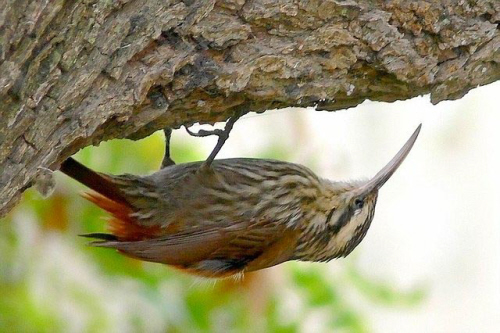
"Yellow-chinned Spinetail Photo by Alec Earnshaw
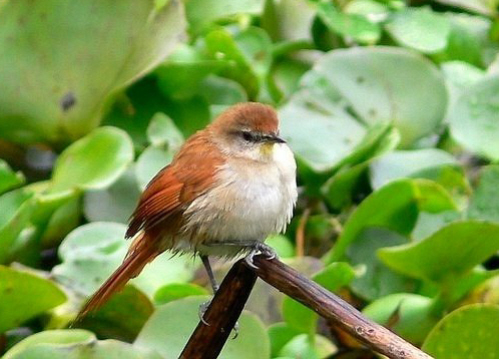
Here is the list from Ceibas
Greater Rhea
White-tufted Grebe
Neotropic Cormorant
Cocoi Heron
Whistling
Heron
Great Egret
Snowy Egret
Woodstork
Maguari Stork
Bare-faced
Ibis
Southern Screamer
Speckled Teal
Silver Teal
Ringed
Teal
White-faced Whistling Duck
Fulvous Whistling Duck
Brazilian
Teal
Black Vulture
Roadside Hawk
Savannah Hawk
Southern
Caracara
Giant Woodrail
Plumbeous Rail (Heard)
Rufous-sided Crake
(Heard)
Red-fronted Coot
Wattled Jacana
Southern Lapwing
Collared
Plover
Greater Yellowlegs
Solitary Sandpiper
Kelp Gull
Picazuro
Pigeon
Spot-winged Pigeon
Eared Dove
Picui Ground-Dove
Monk
Parakeet
Guira Cuckoo
Glittering-bellied Emerald
Field (campo)
Flicker
Green-barred Woodpecker
Narrow-billed Woodcreeper
Rufous Hornero
Curve-billed
Reedhaunter
Yellow-chinned Spinetail
Stripe-crowned
Spinetail
Short-billed Canastero
Chotoy Spinetail
Sooty-fronted
Spinetail
Brown Cachalote
Tufted Tit-spinetail
Little
Thornbird
Rufous-capped Antshrike
White-tipped Plantcutter
White Monjita
Spectacle Tyrant
Many-coloured Rush-Tyrant
Cattle
Tyrant
Great Kiskadee
Tropical Kingbird
Suiriri
Flycatcher
Bran-coloured Flycatcher
Vermillion Flycatcher
Sooty
Tyrannulet
Rufous-backed Negrito
Small-billed Elaenia
Brown-chested
Martin
House Wren
Chalk-browed Mockingbird
Masked
Gnatcatcher
Rufous-browed Peppershrike
Masked Yellowthroat
Sayaca
Tanager
Hepatic Tanager
Golden-billed Saltator
Greyish
Saltator
Red-crested Cardinal
Saffron Yellow-Finch
Rufous-collared
Sparrow
Black-capped Warbling Finch
Great Pampa-Finch
Hooded
Siskin
Screaming Cowbird
Shiny Cowbird
Bay-winged Cowbird
Brown-and-
Yellow Marshbird
Scarlet-headed Blackbird (Heard)
March 19
Its Sunday and the weather is beautiful. We take a taxi to San Telmo the antique and art market. Its very busy with many stores and a plaza of stalls
where we find a Tango Door made by a local artist to take home with us.
"Carlos Bendetsky the artist who creates the Doors"
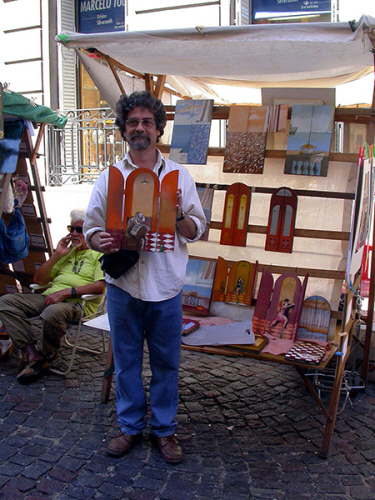
After lunch we walked the dock area but decided not to visit the Reserva Ecologica Costanera Sur. We had been told due to the draught there was almost no
birds. Three years ago I think I saw five species of Coots there, but this time I saw none.
March 20
Its Monday and we decided to visit La Boca settled by Italian fishermen. Caminito (a small road) has very colourful houses, many street stalls and
lots of shops for artisans. Even on a workday there are lots of people there shopping and sitting in the sidewalk cafes. Having a beer in a sidewalk caf I
am approached by a young man of 12 years trying to sell me something. I tell him I do not want anything and then ask him why he is not in school. Karen
translates to Spanish and he tells us he goes to night school; smart kid, and he is the kind who should be at school.
Later on walking behind a mother taking her daughter back to school she tells her to give her sister a kiss and when I complain What about me the mother
just turn around and say Give him one and thats what she did. It good to know there are still places in the world where people are not paranoid about
stranger.
"Tango lessons on the street"
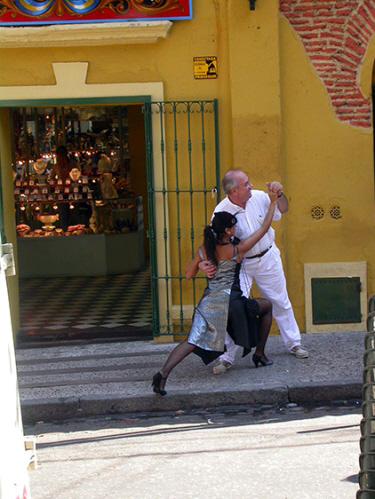
March 21
We are off to Cordoba today and will fly from the small domestic airport close to downtown and the river.
When we arrive in the city of Cordoba we rent a small car in the airport and proceed to drive to La Cumbre. Ruta 38 is a two lane twisting highway up
through the mountains with fairly heavy traffic.
La Cumbre is a small, quit pretty small tourist town where we will stay for a few days.
After driving around for some time we finally found Hostal de la Luna
http://www.delaluna.com.ar/index2.html
carved into the side of the mountain. Things are a little rustic but charming and Gustavo the proprietor
makes us feel welcome right away. It is not tourist season so we have the place to ourselves and people have time to chat and help us.
De la Luna is located on the outskirts of the town but for a dollar or two we can hire a taxi to take us to center where the restaurants are located. All
our meals were excellent and the prices definitely right compared to Buenos Aires.
"De la Luna built into the mountain side"

March 22
Its a beautiful day in the mountains and the air is clean. Before breakfast I explore la Lunas ground and find the swimming pool on top of the mountain.
There are many vultures riding the air currents but I think they are all Black Vultures. I am not lucky enough to have a Condor circling above me the first
day.
Gustavo helps me contact Juan Carlos, a local Birdingpal in Villa Carlos Paz and we make arrangements to go birding the next day. The rest of the day we
play tourists.
March 23
Gustavo told me it would be at most an hour to drive to Villa Carlos Paz, but he was way out. I left at 06.00 and it is still pitch dark and foggy. Between
navigating and driving I am more than half an hour late. Worrying that Juan Carlos will think I am not coming I push through, driving as an Argentinean,
and find the giant Cuckoo clock. He is still there, and a very patient man. After a quick breakfast we take off with Juan Carlos driving the car and a good
thing too because we are headed for the trails in the mountain.
I will let Juan Carlos tell about our day since he is much more of a writer than me and a professional photographer/teacher too.
"Old Trail to Copina"
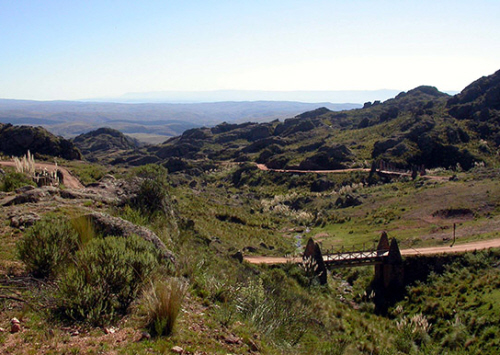
"Juan Carlos the Birdingpal"
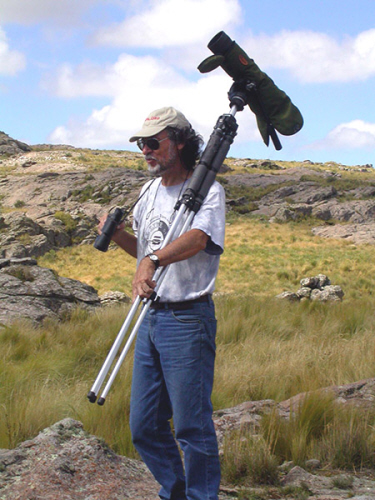
BIRDING WITH KNUD RASMUNSSEN
IN CORDOBA,
ARGENTINA
Last time of summer season occurs in Crdoba Mountains with
alternative currents of cold winds from the Patagonia colliding with subtropical humid air from Brazil. Consequently we had magnificent sun days together with
cloudy day in short spaces of time. For both situations there are many good areas for birding in our low area, but Knud was looking for condors in his visit
of Crdoba. And condors lived in the most hights points of the region where all forces of nature are taking part in this situations for quickly events as warm,
cold, sun, wind, clouds, mist that can change in one moment. Surely, I was playing russian roulette with the weather.
Days before swallows are gone. All
the sky of Villa Carlos Paz, where I live, was covered with black and white wings going to north and some was flying very high, meanwhile others was round
gliding near the roof of my home catching insects in its migration journey. So early as march 4, I saw, at the last light of this day, many Fork tailed
Flycatcher on a line to north in groups of two or three birds each, an event that was repeated others days for the same place at the same altitude. On the
nights I could feel the sounds of the birds contacting each others when they was going it.
Knud had assigned one day of his Crdoba travel for go to see birds
and in his two days options, he prefered the second one. Lucky man !. The first was rainy in the mountains and the informs of the forecast office was:
Unstable for the next days But when in the morning I had mist in my window I was sure that it will be an excellent day. And so, it was.
We met and we
changed presents: three differents Field Guides of Cordoba Birds and a booklet of my photographic work for Knud and a cap of Birdingpal.org and a woodpecker
pin(My club OFO's, Knud) for me. Good. Very good.!!
Villa Carlos Paz is a big city, rounding the San Roque Lake, of 80.000 inhabitants that in summer reach as
far as 130.000 persons. Its 300 hotels cost from U$S 5 per person for a good habitation for sleep to U$S 100 or more with all conforts for enjoy. It was at
450 meter above sea level and we will going rise until 2.250 on the top of the Pampa de Achala. For the first 20 kilometers to southwest we crossed small towns
as San Antonio de Arredondo, Mayu Sumac, Icho Cruz and Cuesta Blanca, developed along San Antonio River, with modern houses owned, greatly, for persons that
work in Crdoba City at 50 km.
This area is very good for birdwatching when you have little spaces of available time. Researching for country roads, near
the river coasts, its possible to find hightlights as Scimitar billed Woodpecker, Spot backed Puffbird, Ferruginus Pygmy Owl, Spot winged Falconet and
many more.
After the last houses of Icho Cruz, the road was in continous ascent and the small patchs of mist remains was lossing behind vegetations and
shrubs. Many common bird are moving near as Great Kiskadee, Rufous Hornero, Brown Cacholote, Shiny Cowbird, Picui Ground Dove, Rock Dove, Cattle Tyrant,
Ringed Kingfisher, Monk Parakeet, Bay winged Cowbird, House Wren or Chimango Caracara. Progressively, in the changing landscape, trees of molles,
cocos,espinillos and duraznillos del campo typicals of the forest mountain, begin to disappear for give it way to places abounding in tall grass.
Knud remembered this route when 3 years ago traveled with his son from Mendoza.
In the first cross-road, we took the old way to Copina, actually discontinuous, for a quickly mountain speedway. We saw, meanwhile we are moving,
Chalk browed Mockingbird, American Kestrel, Long tailed Meadowlark, the first subspecie endemic, Eared & Spot winged Pigeon, Great Pampa Finch. We stopped
and Knud took his telescope for to see other subspecie endemic, Pumbeous Sierra Finch, far on the rocks, together with Grassland Yellow Finch, Chiguanco Thrust,
Saffron Finch and Cinnamon Warbling Finch. A Glittering bellied Emerald cross the sky very quickly and near, behind the shrubs, is singing an Andean Tinamou,
a subspecie endemic.
Near the road, grasses are advancing to its border. Nature, without daily traffic, is going to restore its wild appearance that had
before 1915 when, unpaved, it was open to the old Fort A used at that time. For more than one hundred years the unique form to comunicate with the west
valleys and provinces of San Lus, Mendoza y San Juan was for this trail and only in mules or horses. Who likes more comodities, they needed to look for the
plain routes and maked 500 kilometers in stage coachs for to go at the same place that was situated 100 kilometers for the mountain.
We continue to run over this interesting section that is going up for the edge of the hills, avoidding to build small bridges because this line dont cross rivers or
gutters. The view is very wide with all the mountain chains for us. In the valley, Villa Carlos Paz still was cover with mist as the same that a cup of
milk. Small birds in this area prefer to walk inside the tall grass looking for food. Many Field Ficker are flying and a White winged Mockingbird was singing.
Three Crested Caracara were waiting for winds on post fences, We looked also Hooded Siskin, Grassland Sparrow, Rufous collared Sparrow, Southern Lapwing and
Darwins Tinamou.
Copina, at 1448 m., is actually a settlement of half a dozen houses with a forest of poplars and pine trees where Turkey and Black
Vulture sleep or take for r est. Its a good area for Red tailed Comet, Brushland Tinamou, Green barred Woodpecker, Red backed Hawk, and Black bellied
Shrike Tyrant, a subspecie endemic, but today they are missing.
We began to see more and more Black and Turkey Vulture in the sky and in one moment for other we see the first Andean Condor. Spectacular. Its wings were planeing
without any movements with its black primary wings very open as human fingers and its white necklace very notorious for to be wrong. After this we see other
and then four more. A big day!!.
Road now is going up carved on rock slopes where its was builded hanging bridges. In the first that we crossed we research
into a rock gorge where there were a small stream of water with many acuatic plants and trees. We are looking for Cinclodes and Knud found one. Olrogs
Cinclodes, a subspecie endemic. Moving along the rocks of the stream it was eating insects and small arthropods.
We continue ascending for the unpaved road for to approach El Condor, a small settlement, where we stop to eat some sandwichs. We find among a groups of trees, Hooded Siskin,
Correndera Pipit, Chaco Earth Creeper, Saffron Finch, Chiguanco Thrush, Bay winged Cowbird. A few kilometers more west, there are tiny ponds and we decided to walk around one
of their.
We are now in the Pampa de Achala, at 2200 meter above sea level. Fresh and pure air, is what you respire is this high plateau. With an extension
of 100 km, from the more high point in the province of Crdoba, Cerro Champaqui, at 3030 m., to the second point, Cerro Los Gigantes, at 2370 m, and more or less
15 km wide, the region is part of the sistem of Sierras Pampeanas of 350 km long with south to north orientation.
Originally Pampa de Achala had extensives
forests of tabaquillos an maitenes accompanied with abundant vegetation of shrubs, big ferns, moss and grasses. Today there are more grasses and small
forests in gorges or protected reducts. Diverses birds took this ecological island has permanent habitat as other was only occasionals visitors of summer,
winter or accidentals when birds cross from one valley to other. Many of there evoluted isolately and today was formed subspecies that now are endemic of this
Pampa as Nothoprocta pentlandii doeringi (Andean Tinamou), Geossita cunicularia hellmayri (Common Miner), Geositta rufipennis ottowi (Rufous banded Miner),
Cinclodes comechingonus (Cordoba Cinclodes), Cinclodes oustaleti olrogi (Olrogs Cinclodes), Cinclodes atacamensis schocolatinus (White winged Cinclodes),
Asthenes modesta cordobae (Cordilleran Canastero), Asthenes sclateri sclateri (Cordoba Canastero), Agriornis montana fumous (Lesser Shrike Tyrant),
Muscisaxicola rufivertex achalensis (Rufous naped Ground Tyrant), Phrygilus plebejus narosky (Ash breasted Sierra Finch), Phrygilus unicolor cyaneus
(Plumbeous Sierra Finch), Catamenia inornata cordobensis (Plain colored Seedeater), Sturnella loyca obscura (Long tailed Meadowlark). Subspecie
Cyanoliseus patagonus conlara (Burrowing Parrot) actually is in study.
In the water of the pond we distinguish Lake Duck, Yellow billed Pintail, Speckled Teal, White winged Coot, and near the coast quickly we see White winged
Cinclodes, a subspecie endemic. With the telescope we are looking many little rodents, called cuis, eating grass and we are waiting for an eagle or other
predator but nothing was present. Walking among tall and strong grasses with hidden rocks its not easy, until we saw Grass Wren, maybe a pair with a chick.
Then, in an island of sand stopped a Rufous naped Ground Tyrant, a subspecie endemic and Cordoba Cinclodes, also an endemic.
We rounded the pond, among rocks covered of moss and lichens and diverses native grasses, admiring small patchs of tundra flowers near the ground, like gardens. In different
spots there are many females of Sierra Finch, indistinguishables if there is no male near, but more later we see Ash breasted Sierra Finch, a subspecie endemic. Also, Bar
winged Cinclodes, Cordilleran Canastero, other subspecie endemic and far, flying, there is a Black chested Buzzard Eagle, rounding slowly.
In one rock there was a lizard taking sun, but no a common lizard. This had green emerald and sky-blue colours and also is an endemic of Pampa de Achala. Its name is
Prystidactilus achalensis. A really rarity.
Sun was hard, very hard but we are talking all the time, about birds, our government, our economy, President
Kirshner, Birdingpals, Toronto, Villa Carlos Paz, family, weather, our children, our works, our hopes. In the sky and all around us are hundreds of white
butterflies, many of them passing between us, flying in the same direction moved for the south breeze and in the horizont some clouds are now forming as
towers.
Our last birds that we see were a group of Carbonated Sierra Finch and Rusty backed Monjita, both maybe moving in its annual migration from the
south. At 5.00 PM we take the highway for return, crossing the main entrace to Quebrada del Condorito National Park, whose purposes are to protect nestling
areas of condores and the ecosystem of mountain grasses. We are counting in my Field Guide to Pampa de Achala Birds all birds of the day that Knud saw: 40,
but not the final number because after this we see Common Miner and the count changed : 41. Not bad.
We are tired but happy. It was a very good day birding
in the mountain. We accord that this night we will have No tango, but yes, good vine!!. For me, not until 11.00 PM, because before I will have to teach an
Advanced Course of Photography and my students are waiting.
I crossed Villa Carlos Paz for the scenic road near Rio San Antonio and stooped near the Big
Cucu Watch, where in the morning I waited at Knud. Say goodbye will be to much for us. Better is, Hasta la vista, amigo.
Juan Carlos Grasso
jcgrasso@arnet.com.ar
"Andean Condor Photo by Juan Carlos Grasso
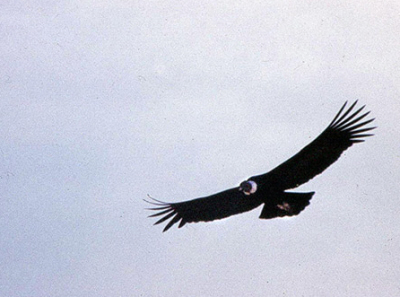
"Andean Condor Photo by Juan Carlos Grasso
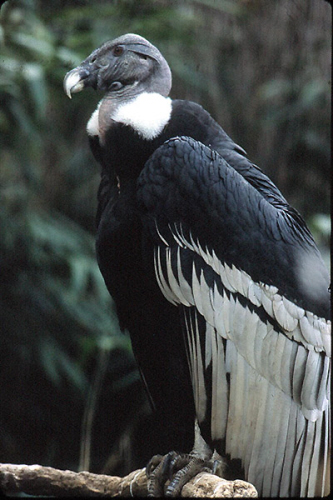
After a great day of birding and camaraderie, I say goodbye to my Pal since he has a class to teach at the university in Cordoba at eight oclock to night.
It was a good thing Juan Carlos drove the car, since I found out that the trail over the mountain is the same one they use for the yearly international
South America rally and to tell the truth, I do not know how the little GM car made it. It was definitely the worst road I experienced during the whole
time in Argentina.
This evening we again found a great little restaurant recommended by Gustavo where the owner was the chef (great pasta) and the waitress the singer and his
girlfriend and we almost had a party there. I must say we have never met any people who were not friendly and helpful so far.
March 24
I settle the bill and say goodbye to Gustavo, and we can certainly recommend his establishment to any one visiting La Cumbre.
We are off for San Miguel de Tucuman this morning but first we had to pick up a tire a local gas station repaired for us.
Again, a beautiful day, and we are making good time. The road is fine until suddenly we run out of asphalt and the road gets progressively worse. According
to the map, it is the right one but after half an hour we come to a tee. Right or left?? A couple of old gauchos are leaning against a fence talking. I ask
for help and one of then draw a map in the sand and indicate we have to go to the cross. Turning around we find several Crosses and ask for help several
times until we meet a senora and her kid on a moped on a third Cross road who tells us its the next Cross. When we get there, it is good news, since
it is paved. They just forgot to put a sign up at the intersection but we found one after driving down the road a few kilometres. The rest of the trip to
Tucuman was fine and we enjoyed the changing landscape.
Arriving in Tucuman, we bypassed the city since we planned to stay at Vila Loletta
http://www.vila-lolette.com.ar/vilalorette_eng.html
located in the small village of Villa Nougues in the mountains above.
The hotel is a beautifully restored old summer residence with 2 foot thick stone walls. This is a place where the real old money of San Miguel de Tucuman
spent their summers, and they still do. The view from our room of the valley with the city below is fantastic and the restaurant turned out to be great. We
had the place mostly to ourselves. This is not tourist season here but judging from the inns guestbook, we were not the only travellers who have found this
gem of a guesthouse.
"Villa Loletta"
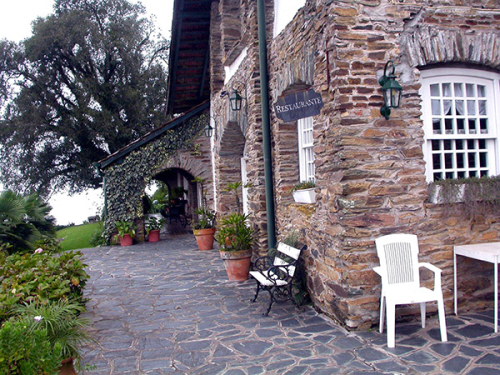
"Lobby in Villa Loletta"
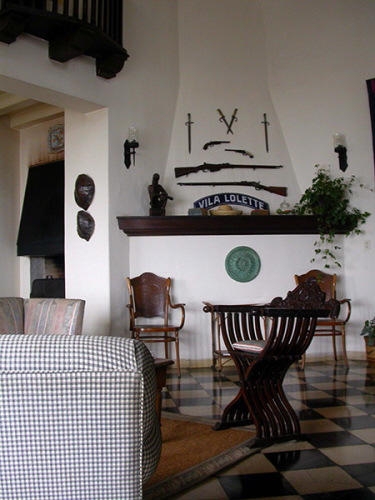
March 25
This is the only place where I did not have a local Pal but the hotel informed me before we arrived that they would have a local guide to show me around. I
did have my doubts about birding but contacted Pablo Zelaya Huerto and made arrangement to meet the next day.
We then drove down to Tucuman, a city with much history but still many economical problems. Since it was Saturday, the downtown was filled with people but
suddenly they all disappeared around 13.00. They take their siesta seriously here. We entered a restaurant for lunch and they tried to get us to leave by
ignoring us. But being hungry and thirsty we decided to stick it out and a waiter finally came up with a menu. It was a good thing we did because we had
the best grilled chicken during the whole trip (I am sure they were free range too).
March 26
Pablo arrives at Vila Loletta at 09.00 and he turns out, as I suspected, not to be a birder but a very nice young man who owned a mountain biking and
camping tour company. Taken off in his four wheel truck, I realized he knew the mountains and forest very well and even if it was a foggy and cool day we
did see a few birds. The problem was that neither he nor I could identify a good part of them. Pablo took me to a small nature park (a whole mountain)
covered with forest and we started to trek up one of the trails where we met several joggers coming down. They were very fit people, since the mountain is
about 1500 meter tall and quite steep. I think the park will be quite good for birding since there are few people, no livestock and motorized vehicles are
allowed, and it looks like the rules are enforced. Not surprisingly, Pablo was amazed of how many different birds we discovered, and I think I turned him
into a birder. Well, thats not too difficult, when one starts to really look at the birds and the rest of nature.
After I returned Pablo send me some of his new bird pictures and here is one
"White-tailed Hawk Photo by Pablo Zwlaya Huerta"
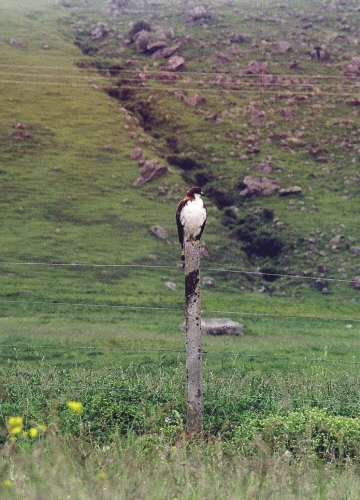
Tonight we had company at the inn, since six bikers showed up. 3 BMWs, 1 Honda Golden Wing and 2 Harleys.
Small summer residence in Villa Nougues"
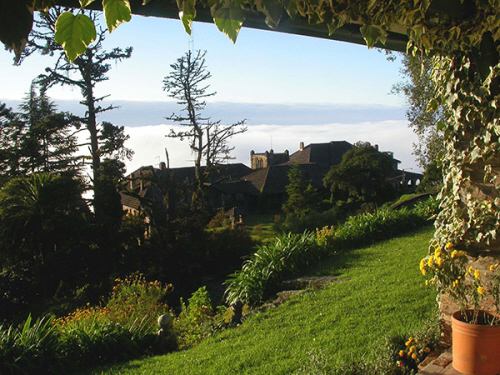
March 27
We start out early in the morning for San Salvador de Jujuy driving up into the mountains and bypassing Tucuman. It was a beautiful drive, and the weather
is again co-operating.
Above the clouds on the way to San Salvador de Jujuy"
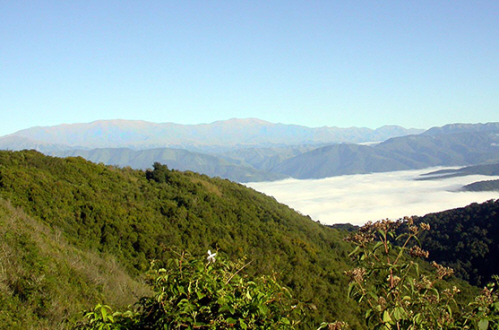
The roads are twisting but in good shape, only one toll and one police check where the officer spoke French to us when he found out we were Canadians.
Arriving in Jujuy, we find our B&B without too many problems. Hosteria Pascana (pascanajujuy@yahoo.com.ar) recommended by a local Birdingpal, is a spotless private home with our room
facing out to the also spotless garden.
Hosteria Pascana from the garden"
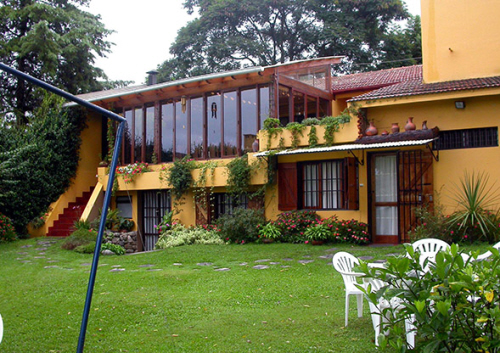
Senora Parodi the owner, a retired theology professor, makes sure all is taken care of. She calls for a taxi and negotiates the fare to take us to a
restaurant. We are quite exited because from what we know, this is the only part of Argentina where they use more than white pepper to cook with, and we
are not disappointed.
I contacted Francisco Cornell, a local Birdingpal, and make arrangement to meet for dinner. Our dinner is also local dishes and Francisco and I make
arrangements for meeting early next morning in search of the Dipper.
March 28
Francisco and I leave when its still dark and arrive in Yala Lakes Provincial Park. The first bird we saw was the Lyre-tailed Nightjar and within 20
minutes Francisco produced not one but two Rufous-throated Dippers, and, to top it a Torrent Duck. Both are lifers for me.
There was a small water filtration building close to the stream with a single light stand, (still on when we arrived) surrounded by trees and bushes
and everything just covered in moths and other insects. The birds just came to us. Amazing.
Francisco is a very knowable birder and it was a joy to spend a day with him. However, at the end of the day, disaster struck. My Pal had been kind enough
to check the birds we saw in my Birds of Southern South America and Antarctica so I did not have to use my reading glasses. Somehow it had disappeared.
Devastated, Francisco insisted on backtracking but we did not find my book. It had all my notes from not only this trip, but also the one three years ago.
Well, things happen Francisco, so do not worry about it, I will survive and get a new one.
Here is the list I would never have gotten without the local Birdingpal. Thanks Francisco.
Dipper country"
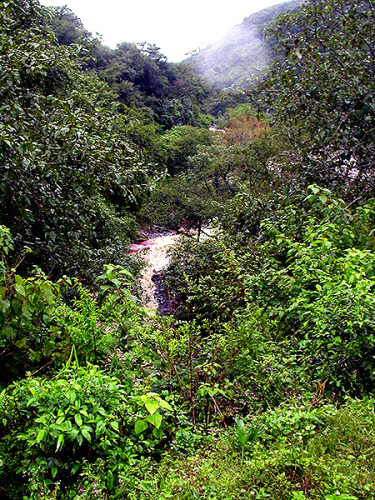
Francisco the Birdingpal"

Yala Lakes Provincial Park and a few other places
Pied-billed Grebe
Neotropic Cormorant
Snowy Egret
Maguari
Stork
American Woodstork
Buff-necked Ibis (flying flock in the
dam)
Roseate Spoonbill
Yellow-billed Pintail
Speckled Teal
Torrent
Duck
Black Vulture
Roadside Hawk
Southern Crested
Caracara
Red-gartered Coot
White-winged Coot
South America
Stilt
Southern Lapwing
Solitary Sandpiper
Picazuro Pigeon
Picui
Ground Dove
Lyre-tailed Nightjar
White-bellied Hummingbird
Dot-fronted
Woodpecker
Rufous Hornero
Crested Becard
White Monjita
Black
Phoebe
White-winged Black Tyrant
Cattle Tyrant
Yellow-browed
Tyrant
Great Kiskadee
Tropical Kingbird
Dusky-capped
Flycatcher
Greater Pewee
Streak-throated Bush Tyrant
Mottle-cheeked
Tyrannulet
Vermilion Flycatcher
White-throated Tyrannulet
Small-billed
Elaenia
Black-and White Swallow
Plush-crested Jay
Rufous-throated
Dipper
House Wren
Rufous-bellied Thrush
Chiguanco Thrush
Swainson`s
Thrush
Red-eyed Vireo
Brown-capped Whitestart
Tropical Parula
Masked
Yellowthroat
Slaty Flower Piercer
Common Bush Tanager
Fawn-brested
Tanager
Blue-and-Yellow Tanager
Golden-billed Saltator
Black-backed
Grossbeak
Fulvous-headed Brush-Finch
Double-collared Seedeater
Saffron
Yellow-Finch
Rufous-collared Sparrow
Rusty-browed Warbling-Finch
Great
Pampa-Finch
Hooded Siskin
Golden-winged Cacique
"Plush-crested Jay Photo by Francisco Cornell

"Turquoise-fronted Parrot Photo by Francisco Cornell
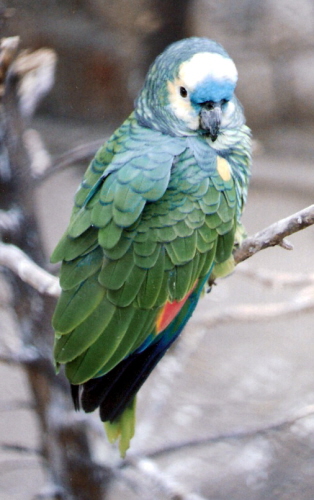
This is not the end of the day. When we returned to Hosteria Pascana, Silvia and Carlos, also Birdingpals, called and told me they where in town so we made
arrangement to meet for dinner.
Silvia and Carlos live Calilegua/Jujuy and are close to El Rey/Salta National Park which they protect fiercely. Here they own a ranch and eco-lodge. We did
not have time to visit them, but next time we will have more time for their place and the North-West of Argentina. Jujuy ranks high on the list of best
places in Argentina but I have to stop in Salta next time also.
I was very disappointed when the waiter told me no Llama tonight but I did have pickled ox tongue as an appetizer. After dessert we had coca tea and Silvia
arranged with the waiter that I could come back tomorrow for dinner and have Llama: he would make it as a favor to a foreigner. So you can see Birdingpals
are about much more than just birding.
"King Vulture, the only vulture in South America I did not see and Silvia send me this picture to make me feel better
Photo by Flavio Moschione a local biologist
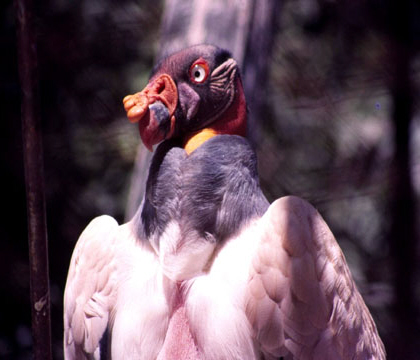
March 29.
We play tourist today in Jujuy and take it easy gearing up for tomorrows trip to Corrientes.
We visit a local museum, shop for artifacts and return for dinner at last nights restaurant and sure enough George has Llama ready for me plus extra spicy
sauce to compliment our dinner. We are still amazed when we get the bill, but I guess thats Argentina away from Buenos Aires and Iguazu.
San Salvador de Jujuy"
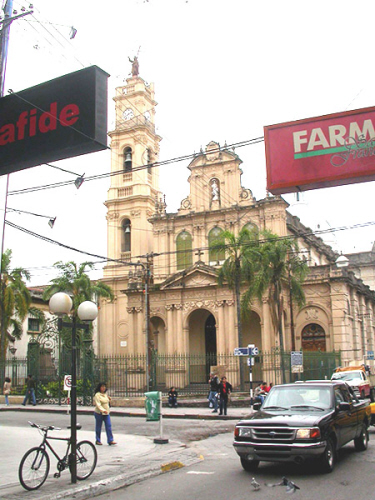
March 30
This is Karens fire test, 1000 kilometres to Corrientes.
We say goodbye to our host Senora Parodi who is up early serving us breakfast and to speed us on our way. Again it is a beautiful day, roads and traffic
are good until we turn on to Ruta 16. Shortly after, we hit the worst highway during the whole trip. Giant (and I mean giant) potholes,long stretches of
broken pavement, and its like driving a rally in order not to loose too much time. At one point we were wondering why certainly there was a lot of traffic
in both directions until we came upon an overturned trailer. No one was hurt but the entire population was helping themselves to groceries. They were all
carried away by people on bicycles, horses, walking etc. and closely supervised by the local police. Around Joaquin V. Gonzalez, the road improves and we
make good time. Just before entering the province of Chaco we run into a police checkpoint manned by one lone officer. After checking my international
drivers licence he started talking about a car tax and Karen asked him to write down how much. No problem for him and he wrote 20 pesos in her notebook.
When I took my wallet out I only had one 5, one 10 and one 50 pesos bill and since he would not give me change on the 50 but indicated he would take it
instead of 20 I said no way. After a few minutes of discussion, he pointed on to the 15 pesos and said OK amigo, you can go. In some ways it was kind of
comical but also a bit intimidating. I guess the local cops also have to feed their families.
For this drive there was not much time for birdwatching but Chaco has some excellent places to bird. Maybe next time?
We arrived in Corrientes around 17.00 and after a bit of trouble (no street signs etc.) we found our hotel
Grand Hotel Guarani.
That night we dined on fresh Surubi, river fish with a nice bottle of white Argentinean wine.
March 31
Another beautiful day and we are off to meet Sergio Corbet and his wife Mathilde in Posadas. Sergio is from Buenos Aires and the first Birdingpal in
Argentina who joined five years ago.
We make great time until we are stopped in Posadas waiting for the light to change so we can make a left hand turn. Then a city bus come barrelling
through also making a left hand turn from our right side rips the front end off the car and does not stop. After the first shock I take off after the bus
and catch up a couple of blocks away, cutting him off. I still remember the drivers face when he saw two foreigners jumping out telling him he just
committed hit-and-run and Karen starting to take notes. Then he tried to drive over me and the car and I felt like the man on Tiananmen Square stopping the
tank. A young lady passenger came out to help us and after taking the necessary information, we left to look for Sergio and Mathilde who did not know why
we were not showing up at the prearranged meeting place. After making contact, Sergio and Roberto took me to the police station to file a report and then
made arrangements with the rental company to get the vehicle fixed. Thank God for Argentinean friends; it would have been a nightmare with out them.
After lunch, we are off to Colonia Carlos Pellegrini in the Ibera marshes where the owner Elsa Guiraldes had invited us to spend a few days at the Posada
de la Laguna lodge
http://www.posadadelalaguna.com/.
Its about a three hour drive from Posadas in a four-wheel vehicle on very rough roads, but Roberto the owner of the transportation
company, who helped me out at the police station, got us there safe and sound.
Posada de la Laguna is a very comfortable lodge located right on the lagoons and you can contact Senora Elsa direct if you want to (posadadelalaguna@ibera.net)
Posada de la Laguna"
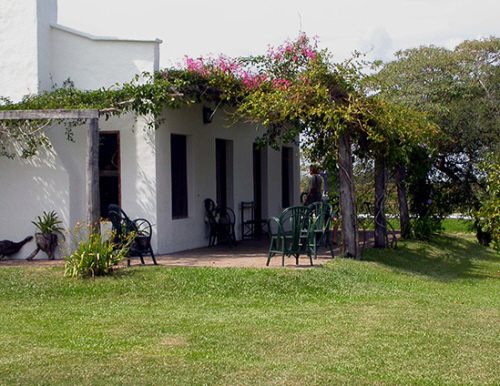
April 01
Its a gorgeous morning and Sergio, I and our guide Mat are up early to go birding on the lagoon in the lodges powerboat.
What a great place to bird
but I will let Sergio give you an idea of the potential here:
"THE IBERA MARSHES.
The "Ibera Marshes" are slowly becoming an internationally popular place visited mainly by naturalists and birdwatchers. This huge oval shaped lowland pan mostly filled
with fresh water carrying an enormous number of different vegetation is found in Argentina some 500 miles to the northeast from Buenos Aires in a province called
Corrientes.
About 13 years ago the provincial government decided that in the Ibera area a 3.5 million acres patch should be spared and declared a Provincial
Nature Reserve while lately it also has been declared a Ramsar Site, thus stopping there all hunting, trapping and casual logging in order to preserve
such a fine unspoiled and amazing natural wonder for future generations. The whole area has a very small population living in several villages strewn here
and there and in still surviving cattle ranches. Some very particular conditions make this a very special place. At Ibera, the climate is warm and humid. It
often rains yet this never becomes a nuisance mostly allowing birders to bird all day round. Vapors provide sufficient humidity generating feed-back with
rains refilling the marshes. The vegetation in every sense is abundant and grows on land and in or under the shallow water in such huge masses that it often
helps to build with the entangled reeds floating fertile rafts with new vegetation growing on top of them. Myriads of different flowers attract all
sorts of insects, birds, reptiles and amphibians as well as mammals. Another particularity found at this place is the presence of three different types of
soil, all very close to one another carrying different vegetation and interspersed with water flows sometimes making huge lakes like the 12,650 acres
Ibera Lagoon.
At the "Ibera Marshes" the most popular place for nature and birdwatching is a small village by the name Colonia Carlos Pellegrini found on
the shores of the Ibera Lagoon. Several lodges are found there hosting visitors and also providing local services in order to do some fine birding. Starting as
from mid September and up to early March, over 300 different birds species can be seen there, many of them overlapping from such distant areas as the Pampas,
dry south eastern Chaco and the not far away Misiones Rain Forest.
On our last spring season, while driving from Posadas to the "Posada de La Laguna" lodge at the Ibera Lagoon, once inside the Provincial Nature Reserve we started
to see more and more birds. While the road was going through higher land, we saw in the adjacent fields several "Greater Rhea" while a couple of "Spotted
Nothura" kept running in front of our truck. Resting on a fencepost was a "Yellow-headed Caracara" while further on we saw "Chimango Caracara", "Southern
Caracara" and "Aplomado Falcon". Small flocks of "Eared Dove" could be seen flying along or feeding on the ground often joined by "Picui Ground Dove" and
the shy "White-tipped Dove". Not very high up in the sky we saw insects hunting "Brown-chested Martin" and "White-rumped Swallow". Getting closer to the Lagoon
meant having roadside ditches and starting to see more often tall grasses, reed beds and some distant open water. Now birds could be seen everywhere! A "Jabiru"
together with some "Maguari Stork" and "American Wood Stork" were suspiciously eying us while a flock of "White-faced Ibis" were feeding frantically. Not very
far away several "Bare-faced Ibis" together with a couple of "Plumbeous Ibis" stood frozen as if waiting for something to happen. "Cocoi Egret", "Snowy Egret"
and "Cattle Egret" could be seen everywhere often joined by the beautifully colored "Roseate Spoonbill". Flocks of "White-faced Whistling Duck" and
"Brazilian Duck" would fly away while couples of "Southern Lapwing" stood loudly calling getting a hoarse reply from several "Southern Screamers". A pair of
tail-wiggling "Giant Wood Rails" quickly ran into the reeds seeking shelter while a "Chicli Spinetail" hurriedly hid into the tall grasses. Meanwhile on the
fences wires we saw sitting "Saffron Finch" and "Rufous-collared Sparrow" while balancing on the grass stems close to the panicles we saw feeding
"Double-collared Seedeater" and "Rusty-collared Seedeater". While driving on, sitting on another fence post we saw several "Field Flickers" playing among
themselves hide and seek. Upon arrival to the Lodge, we were greeted by a "Red-crested Cardinal" and in a nearby tree we saw a "Golden-billed Saltator"
and a "Greyish Saltator" not far away. Considering that we had still a lot of daytime, we went for a walk around the Lodge's park. This allowed us to see a
"Squirrel Cuckoo" and a "Dark-billed Cuckoo" while feeding under a bush we discovered several "Ruddy Ground Dove". Insects flying in the late afternoon
attracted such birds as "Great Kiskadee", "Tropical Kingbird" and "Vermilion Flycatcher". Now it was getting dark and to our delight several nighthawks flew
along. It wasn't difficult to identify the "Nacunda Nighthawk" soon jined by the "Scissor-tailed Nightjar" and the "Pauraque". After dinner we went owling and
saw the "Tropical Screech Owl", "Burrowing Owl" and "Short-eared Owl". While walking back to the Lodge on a fence-post the glint of the red eyes gave out a
"Little Nightjar" apparently taking a rest.
Starting early on the next morning, we took a boat ride along the shores of the Lagoon. Flocks of birds were coming out of the reeds and we saw "Unicolored Blackbird",
"Yellow-winged Blackbird" and "Scarlet-headed Blackbird". Walking among the Water Lilies'leaves many "Wattled Jacanas" were seen feeding with their chicks. Also feeding on high
flying insects we saw "Grey-breasted Martin", "Blue Swallow" and "Cliff Swallow". Now we were drifting along the lagoon's shore and from time to time we
were preceded by "Amazon Kingfisher" and "Green Kingfisher". At a place, when turning around some reeds we were greeted by a loud calling "Donacobius" and
then found a hanging nest of a "White-headed Marsh Tyrant" with mom and dad feeding the chicks. A lot of "Snail Kite" were seen so we supposed that these
had a good supply of snails around. While going on open water we were "investigated" by a "Gull-billed Tern" and not far away a couple of
"Yellow-billed Tern" were taking dives at fishes invisible to us. We now arrived to a group of trees growing not far away from the water. Several "Neotropic Cormorant" sat
drying their wings while an "Anhinga" took off. In the branches of a tree we discovered a "Great Black Hawk" resting and upon our departure a
"Black-collared Hawk" arrived landing on top of a broken palm tree. Farther away we discovered a couple of "Muscovy Ducks" flying and then landing on a large
tree branch. On we went, looking this time for "Rufous-sided Crake" which we heard calling not far away. It obligingly showed up at almost a handshaking
distance! Quite close there was a little sand bar and on it we saw feeding.
"Pectoral Sandpiper", "Lesser Yellowlegs", "Common Snipe" and "Azure Gallinule". While going back to lunch, several "Great Egret" were seen while a
"Ringed Kingfisher" ignored our presence so concentrated it was on fishing. Now thermals were going up and we saw "Black-headed and Turkey Vultures" slowly
gliding seeking height. We then discovered a "Lesser Yellow-headed Vulture" trying to catch up with the rest. Just before lunch we saw "Rufous and
Creamy-bellied Thrush" and a "Variable Antshrike". A blossoming vine attracted several Hummingbirds that seemed more concerned at chasing one another than
feeding. Anyway we saw "Black-throated Mango", "Glittering-bellied Emerald", "Gilded Saphire" and "Blue-tufted Starthroat". After lunch we decided to go out
into the fields in a higher land area. Now we saw "Pinnated Bittern", "Rufescent and Fasciated Tiger Heron". While slowly driving along the road, we saw "Striped
Cuckoo" and "Smooth-billed Ani". A bit farther away majestically sitting on a pole was a "Savannah Hawk". Then on some tall grasses we managed to see a
"Strange- tailed Tyrant" and nearby a in a field a "Tawny-bellied and Dark-throated Seedeater" showed up. "Fork-tailed Flycatchers" were busy pursuing
one another. In a nearby tree a "Green-barred Woodpecker" was calling nervously while a "Spot-winged Falconet" flew over us. We then drove into an area with
local "Mesquites and Acacia" trees and thorny bushes among others. A "White Monjita" greeted us, followed by a "Yellow Cardinal". On we drove to discover in
an adjacent field flocks of "Brown and Yellow Marsh birds", "Yellow-rumped Marshbirds" and the rare "Saffron-cowled Blackbird"! Close to some trees we saw
a "Firewood Gatherer" and then "Narrow-billed and Scimitar-billed Woodcreeper". The loud greeting call of a couple of "Brown Cacholotes" gave them out and we
saw them in detail. At another group of trees we discovered a whole family of "White-barred Piculet", "Checkered Woodpecker", "White Woodpecker" and "Little
Woodpecker". Sitting on a completely dry branch as if showing its beauty on a competition sat a "Purple-throated Euphonia". On our trip back to the lodge a
"Lark-like Brush-runner" obliged while upon arrival we saw "Picazuro and Spot-winged Pigeon" flying around seeking a place to roost. That late afternoon
a flock of "Monk Parakeet" fared us good night.
Sergio Corbet.
Here is some of Lip Kee's photos
"Burrowing Owl Photo by Lip Kee Yap
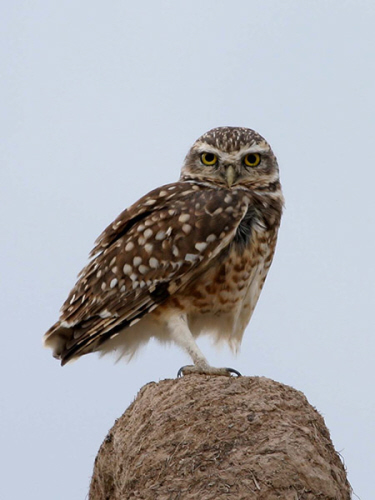
"Green Kingfisher female Photo by Lip Kee Yap"
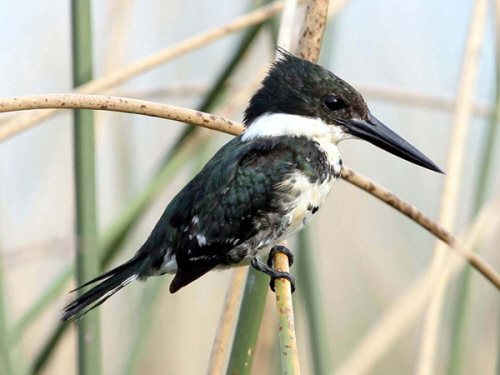
"Smooth-billed Ani Photo by Lip Kee Yap"
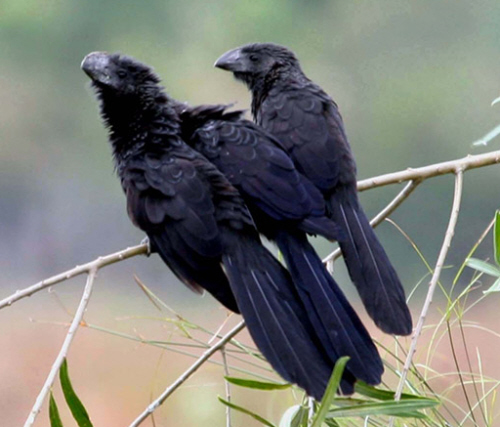
"Lineated Woodpecker Photo by Lip Kee Yap"

"Saffron-cowled Blackbird Photo by Lip Kee Yap"

"Squirrel Cuckoo Photo by Lip Kee Yap"
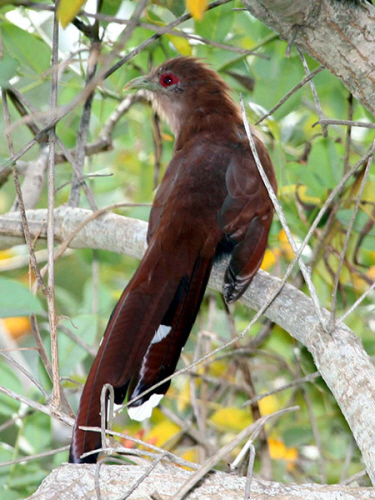
At noon Lip Kee a birding client of Sergio, and his wife Rachel and daughter Yen Li from Singapore join us for lunch. Lip Kee is a very keen photographer,
who took hundreds of bird pictures every day.
Late afternoon we drive off in the lodges four wheel truck to do some birding before it gets dark.
After dinner we admire a very clear sky with a multiplicity of stars Southern Cross, Milky Way and Tres Marias.
Since we left Buenos Aires we have enjoyed the clean air here in Argentina and we are not looking forward to getting back to Toronto with its smog alerts
during the upcoming summer.
April 02
Sergio, Lip Kee, Mat (our guide) and I explored the lagoon again with many birds, capybaras, caimans and fauna. Even Karen, Rachel, Mathilde and Yen Li,
who are not birders, went out on the lagoon and were impressed with the wildlife and nature of this vast wetland. Later they visited a local artist to
purchase a few items to remind us of this beautiful place.
We had 134 species of birds, highlighted with a large flock of Saffron-cowled Blackbirds and
a Scimitar-billed Woodcreeper.
The Guava and other trees around the dinning room building was frequently visited by many kinds of Hummingbirds, Parrots, and Squirrel Cuckoos to name a few.
At night time many Cane Toads, (an imported pest) hunting for large black beetle, left droppings the size of a small dogs on the lawn.
April 03
We could have stayed here in Posada de la Laguna much longer but we are off to the famous waterfalls in Iguaz today.
The four wheel picks us up and drives us and Mathilde to Posadas. Mathilde is flying back to BA this afternoon leaving Sergio to take care of the
Singaporeans who we will meet in Porta Iguazu tomorrow.
Upon picking up the rental car, I am only charged 15 pesos for parking, thanks to the efforts of Sergio and Roberto.
On the way to Iguazu we stop to have a look at the famous Jesuit ruins of San Ignacio.
Jesuit ruins of San Ignacio"
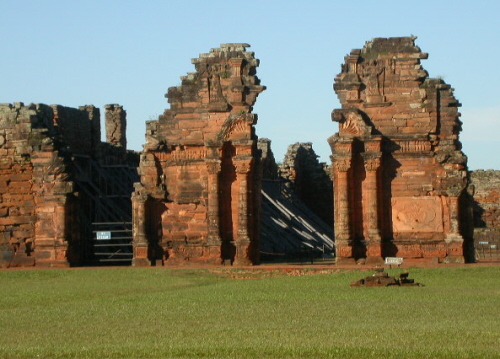
The landscape now changes dramatically with forested hills, many rivers and wetlands. Traffic is quite heavy because of the many logging trucks using the
twisting roads.
Its not safe to bird too much when you drive but I did get a glimpse of a Swallow-tailed Flycatcher sitting on a power line. A late migrant and only one I
have seen since Brazil.
Arriving in Puerto Iguaz, we check in to Las Orquideas Palace Hotel
http://www.orquideashotel.com/pop.html.
a large comfortable motel style inn on Ruta 12 not far from the falls and the port of Igazu.
April 04
This is the first time for Karen to visit the famous falls of Iguaz so we play tourists today. The falls still manage to be reasonably unspoiled on the
Argentinean side but many more people are here than when I visited three years ago. It is still well worth it to spend a day here. On the trail to catch the t
train in the park, we observed not one but two very co-operative Blond-crested Woodpeckers and they created quite a stir when other tourists realized what
we were looking at.
The town of Iguazu is not very large but has some very good restaurants where one can have an excellent meal for a reasonable price.
I make contact with Daniel Somay and Susanna, local Birdingpals, and arrange to go birding early tomorrow.
"The falls of Iguaz"
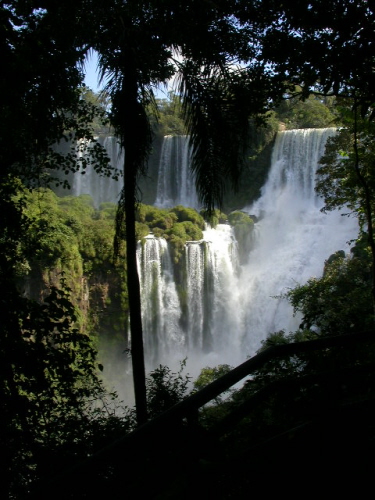
Black Vulture resting above the falls"
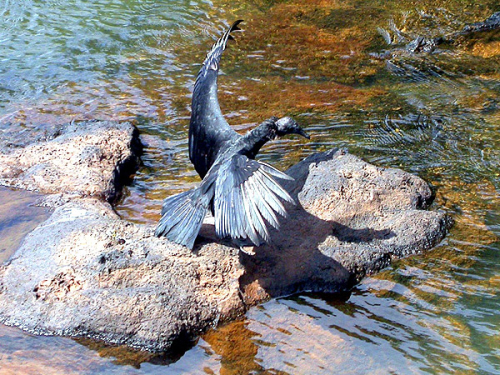
April 05
My alarm clock does not go off so I scramble to get out to meet Susanna and Daniel as well as Peggy, a birder from Illinois, in front of the inn. The first
thing they do is pointing out a Chestnut-eared Aracari sitting in a tree across the road. A lifer for me and in the excitement I forget to take my boots
with me. Too late, I am barefooted in my sandals and hope not to step on any snakes or giant ants.
We are heading back to the falls and park the car close to a ranger research building and walk up the Macuco Trail.
Daniel, an ex-ranger in the park, is a very experienced birder and nature guide, and he knows where and how to find the birds.
It starts to rain and we seek shelter on the veranda of the old Sheraton hotel (now closed) where Daniel serves breakfast and we are closely watched by a
cute Ochre-collared Piculet. While its still raining we move over to the main entrance of the new Sheraton hotel, where we bird, much to the surprise of
the departing guests.
We also run in to Sergio and Lip Kee who have more luck with poisonous snakes and Lip Kee has the pictures to prove it.
It was just a great morning, and despite the rain, we have 50 species in a few hours.
We return to my hotel, where we have lunch with Karen. We are very lucky to meet so many kind and interesting people on this trip.
In the afternoon we visited Jardin de Picaflores, the famous Hummingbird garden in the city. Located in a residential area we had seven species of
Hummingbirds and some even tried to feed off a red flower on Karens blouse.
"Black-throated Mango Photo by Lip Kee Yap"
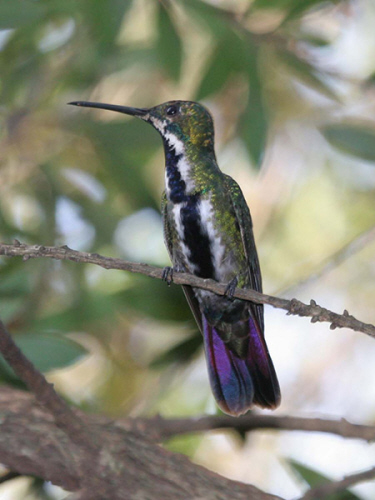
"Black-throated Mango Photo by Lip Kee Yap"
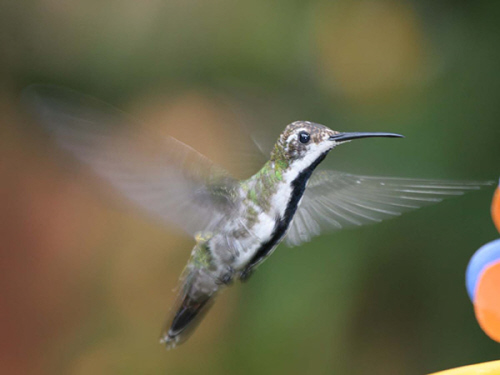
We had dinner with the Singaporeans and Sergio that night and said our goodbyes since we are leaving early the next morning. It was enjoyable to spend a
few days with Lip Kee and his family and hope to see them again some time.
Here is the list from Iguaz
Hotel Orchidea Palace.
Chestnut-eared Aracari
Boat-billed Flycatcher
Yacaratia Trail.
Sirystes Flycatcher
Surucua Trogon (pair)
Rufous Gnateater
Magpie Tanager
Red-rumped
Cacique
Scaly-headed Parrot
Toco Toucan
Squirrel Cuckoo
Old Sheraton Hotel.
Cattle Tyrant
Ochre-collared Piculet
Violet-capped
Woodnymph
Crested Caracara
Sheraton Hotel terrace and grounds.
Grey-breasted Martins
Blue Dacnis (pair)
Pale-breasted
Thrush
White-eyed Parakeet
Sayaca Tanager
Chalk-browed
Mockingbird
Smooth-billed Ani
Yellow-bellied Elaenia
Violaceous
Euphonia
Chestnut-bellied Euphonia
Swainsons Flycatcher
Tropical
Parula
White-crested Tyrannulet
Chopi Blackbird
Social
Flycatcher
Great Kiskadee
Rufous-collared Sparrow
Rufous-bellied
Trush
Green-headed Tanager
Bananaquit
Jargin de Picaflores.
Black Jacobin
Violet-capped Woodnymph
Versicoloured Emerald
Planalto Hermit
Black-throated Mango
Glittering-bellied Emerald
Gilded Hummingbird
A few more birds I saw in Missiones
Fork-tailed Flycatcher
Black Vulture (in the park)
Blond-crested Woodpecker (pair in the park)
and many more but I did not keep track.
"Surucua Troganr Photo by Photo by Lip Kee Yap

April 06
We are again very lucky with the weather and we leave for Paso de los Libres, a small town on the bank of the Uruguay River half way to Buenos Aires.
Driving south through hilly twisty roads, sub-tropical vegetation and the dark red soil we have come to expect in the Province of Missiones, we passed many
large properties with well kept gardens and small villages. Judging by the names it looked like many German settlers came here many years ago and they still
speak German in the stores.
As we progressed the landscape became flatter and the red soil began to subside.
Arriving in los Libres we found a very sleepy little town where everyone was still on siesta. We checked into Hotel Alejandro
http://www.alejandroprimero.com.ar/,
a somewhat tired little place but everything works and the price is right.
There is not much here, even the bird was scares but they did know how to grill a good Argentinean steak.
April 07
Off to Buenos Aires, and I know the traffic will be heavy most of the way. Crossing into the Province of Entre Rios we had our second incident with police
at the first checkpoint. When we stopped and I showed my international driver license, we were told to pull over by one of the officers and the second
officer left immediately. Since our Spanish is some what limited, we did have some difficulties understanding the officers instructions. We offered to
show our passports, but he told us he was not interested. The officer then started to search our rented vehicle and ordered me to unload all luggages from
the trunk. He did not search the luggage and told me to place it back again and indicated we should follow him in to the checkpoint station, where he
showed us a first- aid kit. The officer then told us that according to local laws each car must have such a kit. Since we did not have any (and the rental
company did not supply one), he fined us 300 pesos and asked for cash. Both Karen and I were rather intimidated by the armed officer and I gave him three
100 pesos bills, which he took and just threw in to his office desk drawer.
We were then told to leave, but to stop in the nearest city to purchase a first aid-kit and he would call ahead to the other check points on Ruta 12 so the
officers could make sure we had the kit. Interestingly, when all this was going on (approximately half an hour) no one was manning the check point and all
cars and trucks passed freely.
Shortly after we left, I realized I did not get a receipt for the fine but because of the intimidation we decided not to return to get one. I did contact
the authorities when I returned home to complain but have had no answer so far.
The rest of the trip to Buenos Aires was uneventful but we had a lot of trouble getting to the Art Hotel
http://www.arthotel.com.ar/.
This hotel comes highly recommended and the
location is great right off the Santa Fe, but their rooms are nothing to write home about, thats for sure.
April 08
We just relaxed since tomorrow we leave for the south of Buenos Aires for a few days.
April 09
Its Sunday and the traffic is sane and we arrive in the little village of Caril on the Atlantic coast. When you drive here you have to be very alert and
according to the Herald (Buenos Aires English newspaper) this is the most dangerous place to drive even if the roads are OK.Must be the drivers?
Caril Village is a resort located in a forest of tall pine trees and a playground for city people in the summer
http://www.carilovillage.com/.
There is a small shopping center with several restaurants, surrounded by many large summer residences close to a beautiful wide sand beach. The first thing I noticed was the
absence of garbage on the beach. We visited the opposite side (North Jutland) of the Atlantic last fall and they surely can learn something from the Argentineans about
keeping their beaches free of garbage. Shipping traffic could be the reason, since we never saw a ship during the entire stay and in North Sea there was a
constant flow of tankers, containerships, fishing boats etc. day and night. I did see a fair amount of waterfowl on the way down but here in the pine "forest"
you only find a lot of Picazuro Pigeons and Monk Parrots. Throw in the odd Rufous Hornero and Roadside Hawk and thats it.
The resort is very nice, good restaurant, facilities and friendly staff but not too much English.
"Caril Village resort"

April 10
We spend most of the day walking the beaches and the weather was gorgeous. I did go birding early this morning hoping to get some interesting birds, but
only a few gulls and many Road-side Hawks and Crested Caracara acting as scavengers. Sergio had told me there could be a chance for Penguins, even if it
was a little early in the year, but I did not see any. I did see a dead seal on the beach with many scavengers feasting. Being out of season, we had most of the
beaches for ourselves but there were still a few surfers and people fishing and swimming.
"Cottage in the forest"
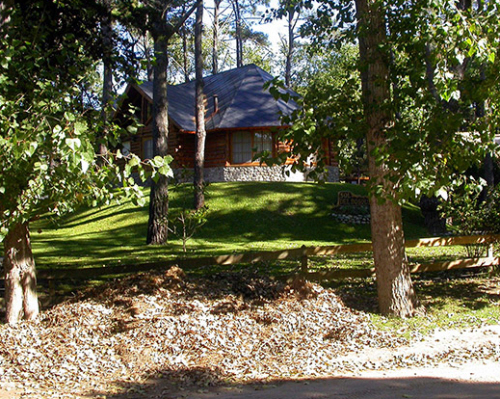
"Ocean beach"
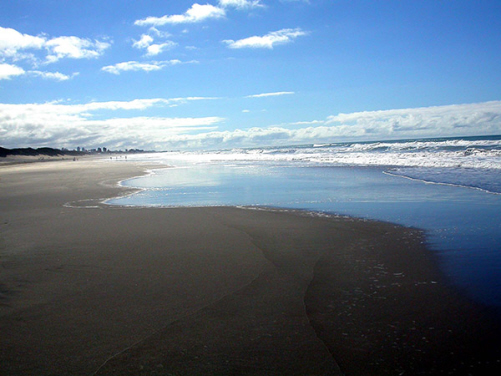
April 11
We leave Caril to return to Buenos Aires in heavy fog but did stop a couple of times to bird the wetland on the way.
Arriving in BA, we experienced the worst traffic ever and it took a couple hours to get to the Art hotel. Here, we found out that the reason was some of
the subway workers had gone on strike: 14 million Porteos were all trying to go somewhere. Checking in at the Art hotel we got the smallest room with the
least amenities but still the same price as a bigger room. I dont think we will favour them with our business again.
Sergio arrived around five oclock and came with me to return the car to the rental company. It was a good thing, since we still had an issue from the
accident in Posadas, but with his usual flair, he negotiated an extra cost of 274 pesos to settle it. We ended up walking back to the hotel since it was
impossible to get a taxi.
We later had our last Argentinean beef dinner with Sergio and we are going to miss him. Thanks Sergio for all your help and companionship.
April 12
This is our last day before returning home and we do a bit of last minute shopping before taking a remise to the airport. We had a bit of a surprise when
we checked in. Air Canada had neglected to tell us that we would fly via Santiago, Chile to get back to Toronto. If I had known that, we would have spent a
couple of extra days in Chile.
It was a great trip with some very good birding and the many people who helped us. I think we will be back again before too long.
Last update 03/05/2013